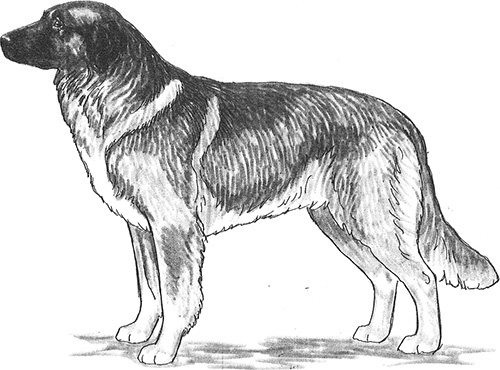Romanian Carpathian Shepherd Dog
Guardian Dog Group (Group change from Herding to Guardian effective: January 1, 2022)
The goals and purposes of this breed standard include: to furnish guidelines for breeders who wish to maintain the quality of their breed and to improve it; to advance this breed to a state of similarity throughout the world; and to act as a guide for judges.
Breeders and judges have the responsibility to avoid any conditions or exaggerations that are detrimental to the health, welfare, essence and soundness of this breed, and must take the responsibility to see that these are not perpetuated.
Any departure from the following should be considered a fault, and the seriousness with which the fault should be regarded should be in exact proportion to its degree and its effect upon the health and welfare of the dog and on the dog’s ability to perform its traditional work.
History
The Romanian Carpathian Shepherd Dog has been used for centuries by the Romanian shepherds in the Carpathian Mountains to defend the herds and guard the camps. Selection was based upon performance rather than breed type until the first breed standard was written in 1934.
The Romanian Carpathian Shepherd Dog was recognized by the United Kennel Club July 1, 2006.
General Appearance
A relatively large dog, rectangular in shape, always giving the impression of agility. Secondary sex characteristics are strongly pronounced, with the males being taller and stronger than the females.
Characteristics
A natural and courageous guard dog, calm, dignified and unconditionally attached to the herd and his master.
Head
Wolf like, powerful but not heavy.
SKULL
Wide and slightly domed, narrowing towards the eyes. Stop must be moderate.
MUZZLE
Approximately the same length as the skull, never longer than the skull. Oval in shape with thick, tight, dark lips and lean cheeks.
TEETH
The Romanian Carpathian Shepherd Dog has a complete set of evenly spaced, white teeth meeting in a scissors bite.
NOSE
Large, wide, and always black.
EYES
Almond shaped, fairly small, set somewhat obliquely. Dark brown in color with tight fitting black rims.
EARS
Triangular in shape, slightly rounded at the tips and set slightly above the outer corner of the eye. Carried dropped and close to the cheeks.
Neck
Medium length, very strong and carried at an angle of approximately 50 degrees to the horizontal.
Forequarters
The shoulder blades are well muscled and moderately sloping.
FORELEGS
Straight, with strong, oval shaped bone and short, slightly sloping pasterns. Length of the foreleg from elbow to ground is one half the height at the withers.
Body
Longer than tall, giving a rectangular appearance. The chest is well developed and deep to the elbows, rather broad. The ribs are well-sprung but never barrel shaped. The back is of moderate length, strong and firm, and the topline is level. The loin is fairly short and muscular and the croup is of moderate length and slightly sloping but never falling away. The underline is gently curving.
Hindquarters
Well muscled with strong bone and good angulation.
HIND LEGS
Very broad in upper thigh with a moderate length of lower thigh, a firm hock joint and a vertical rear pastern.
Feet
Large, oval and compact with well arched toes and resilient pads.
Tail
Set on relatively high, reaching to the hock, at rest it is carried low or saber-like. When the dog is alert it can be slightly above the topline, but never curled or carried over the back.
Coat
Harsh, dense, straight and double. Of moderate length and abundant all over the body, except on the head and the front of the legs where it is short and smooth. Profuse coat is typical on the neck, back of legs and tail.
Color
Pale fawn overlaid with black (wolf grey), often with paler shadings on the under parts of the body. White markings are acceptable but should not be predominant.
Height and Weight
Ideal height at the withers for males is 25½ inches to 29 inches; for females it is 23 to 26½ inches. Weight should be in harmony with the size, giving the impression of strength but not heaviness.
Gait
Free and long reaching, giving the impression of great endurance.
Faults
Any departure from the foregoing points should be considered a fault and the seriousness with which the fault should be regarded should be in exact proportion to its degree.
Disqualifications
(A dog with a Disqualification must not be considered for placement in a conformation event, and must be reported to UKC.)
Unilateral or bilateral cryptorchid. Viciousness or extreme shyness. Albinism.

Looking for a Dog?
Find a dog that will fit your family.
Note: The breeders on this list are not endorsed by UKC.
©Copyright 2006, United Kennel Club
